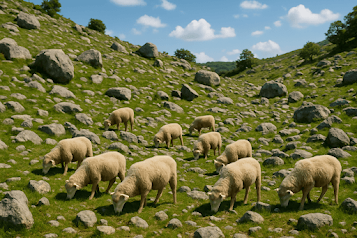Sheep Farming, Raising Sheep, Profitable, Animal Farming, Benefits of Sheep Farming, How-to Start Commercial Sheep Farming.
What is Sheep Farming?
Sheep farming refers
to the practice of raising and breeding domestic sheep for various purposes
such as meat (mutton), wool, and milk.
It can be practiced at a small scale for personal needs or as a
commercial sheep farming business for income generation.
Sheep are resilient
animals that can live in a variety of climates, require less space than larger
livestock, and can graze on rocky terrain. This makes sheep farming ideal for
both rural and semi-urban areas.
Types of Sheep Farming
Depending on the farmer's objectives, sheep farming can be
carried out in a variety of ways:
1. Wool Production Farming
This is the most traditional form of sheep farming. Merino and Rambouillet breeds are primarily
raised for their superior wool.
2. Meat Production Farming
Some breeds are preferred for mutton production. Examples include Dorper, Suffolk, and
Katahdin. These sheep grow fast and have
high meat yield.
3. Milk Production Farming
Some farmers raise dairy sheep breeds like Lacaune and East Friesian, which are not very common worldwide, for the purpose of making cheese and other products made from milk.
4. Dual-Purpose Farming
Some breeds of sheep, like the Dorset and Corriedale, can be raised for both meat and wool, which makes them great for small-scale farmers.
5. Organic Sheep Farming
This involves raising sheep without synthetic feeds,
hormones, or chemicals. It is becoming
increasingly popular due to rising demand for organic products.
Popular Breeds of Sheep
Breed Best For Origin
Merino Wool Spain
Dorper Meat South Africa
England's Suffolk Meat england
East Friesian Milk Germany
Dorset Dual Purpose England
Is Sheep Farming Profitable?
Factors that Affect Profit:
• Breed selection
• Feeding and nutrition
• Land availability
• Market access
• Disease control
• Rate of reproduction
One healthy sheep can produce:
• 2 or 3 lambs per year
• Multiple kilograms of wool
• Mutton that sells at high prices in
many markets
If you rear even 50
sheep, with low cost feed and basic shelter, you can earn a net profit of
$2000–$5000 per year, depending on your country and breed.
Benefits of Sheep Farming
• Low startup cost
compared to cows or buffalo
• Requires less water and land
• Quick returns because lambs mature in five to six months
• Dual income (wool +
meat)
• Strong demand in
both domestic and international markets
• Easy to manage even
by beginners
How to Start Sheep Farming (Step-by-Step Guide)
1. Select the Best Breed
Select the breed based
on your farming purpose (meat, milk, or wool) and climate.
2. Prepare Land and Shelter
• 1–1.5 acres of land is enough for
30–40 sheep.
• Provide simple sheds with proper
ventilation.
• Fencing is important to keep
predators out.
3. Feeding
Sheep can graze on
natural pasture, but supplementing with hay, grains, and mineral blocks ensures
better growth and health.
4. Water Supply
Always make sure
there is always clean water available.
5. Healthcare
• Vaccinate frequently
• Deworm every few
months
• Keep a local vet’s contact handy
6. Breeding
A mature ram can mate
with 20–30 ewes. Lambs of higher quality
are produced under controlled conditions.
7. Marketing
• Sell to local meat
markets or wool factories
• To increase
profits, think about selling directly to consumers from farms.
Cost Breakdown (Example for 20 Sheep)
Item Approx. Price (in USD)
20 Lambs $1200
Shed Construction $500
Feed &
Supplements $400 (6 months)
Vet & Medicines $100
Miscellaneous $100
The total cost of
$2,300 you can expect to recover your investment in 1–2 years with proper care.
Tips for Success in Sheep Farming
• Start small, grow gradually
• Document feeding, growth, and health
• Join local sheep
farming communities or co-operatives
• Learn basic animal care or attend
short livestock courses
• Always plan for seasonal changes
(especially heat and rain)
Conclusion
Sheep Farming is more
than just Raising Sheep, it is also a Profitable and long-lasting farming
method that has the potential to alter one's life. Whether you're looking for a
side income or planning to go fully commercial, Sheep Farming offers low risk
and high return if done properly.
With the right
knowledge, passion, and consistency, anyone can become a successful Sheep Farmer. So, why wait? Start planning your heep farming journey
today!











.jpg)






0 Comments